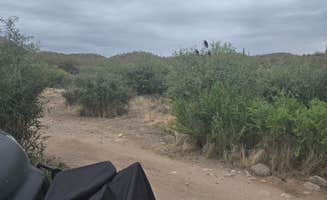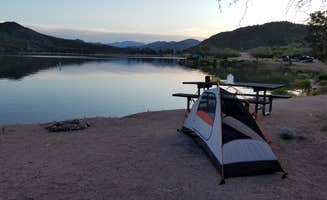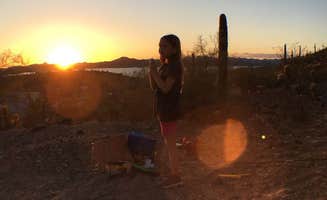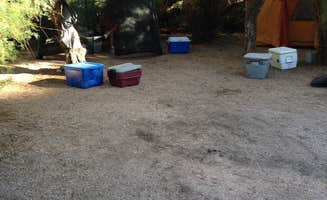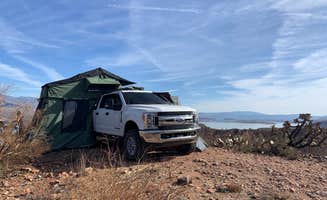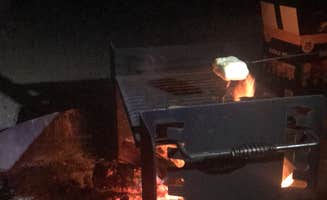Tonto National Forest encompasses over 2.9 million acres of rugged terrain ranging from Sonoran Desert at 1,300 feet elevation to pine-covered mountains reaching 7,900 feet. Camping in Tonto National Forest offers significant temperature variations between seasons and elevations, with lower desert areas regularly experiencing 30°F temperature swings between day and night. Roads throughout the region vary considerably in quality, from paved highways to primitive tracks that become impassable after rainfall.
What to do
Kayak exploration: Paddle up Apache Lake for unique rock formations and wildlife viewing. At Apache Lake Marina & Resort, one camper noted: "We've paddled all over the US and other parts of the world, and the Salt River Canyon still remains one of the most beautiful and most accessible. If you want to avoid boat traffic, go in the early morning or just before sunset."
Star observation: Take advantage of dark skies at more remote camping locations. At Roosevelt Lake - Cholla Campground, a visitor reported: "We spent 3 nights here in February, and while it was chilly, the place was very quiet and the stars were amazing! There are no hookups here, but there are bathrooms with flush toilets."
Hiking with elevation views: Multiple trails offer views across multiple biomes. A visitor at Lost Dutchman State Park Campground shared: "Nestled right at the base of the Superstition Mountains - this is a great location that is close to excellent hiking and riding. Also close to a unique drive out to Canyon Lake! For the very fit cyclist you can ride from this location out this lake."
What campers like
Water access at multiple elevations: Lakes at different elevations provide varied water experiences throughout the seasons. A Canyon Lake Marina & Campground visitor appreciated: "We got a site right on the water. It was amazing! Kind of a beachy water front. We able to kayak right from our site! The campground is kind of small and fill up fast."
Regional park convenience: Usery Mountain Regional Park offers reliable facilities near urban areas. One visitor commented: "This is a lovely regional park to stay in. The sites are well maintained and the visitor center is worth a look. Wonderful hiking trails around the park."
Isolation with accessible amenities: Some locations balance remoteness with basic needs. Regarding Burnt Corral Campground, a camper shared: "Beautiful camping sites! The lake with the mountains in the background is breath taking. The drive down to the campground from the main road is 6 miles but takes about 15 minutes due to the steep winding gravel road. No showers and no cell service!"
What you should know
Permit requirements for dispersed camping: Several areas require permits obtained in advance. For Bulldog Canyon Dispersed Camping, a visitor explained: "Easy to get a permit from the ranger station. Just email your name, address, phone number and driver's license number to sm.fs.mesa_ohs@usda.gov and you'll get your permit within 2 days for free."
Seasonal closures affect planning: Some campgrounds operate on limited seasonal schedules. A camper at Tortilla Campground noted: "Great campground, only open October to March. Water and sewer at each site. No electric hook ups. Close to Tortilla and Canyon Lake."
Road condition variability: Access roads range from well-maintained to challenging. At Hackamore Road Dispersed, a visitor warned: "This is a nice quiet spot with excellent cell service. The road is a bit tricky. I got here pretty smooth on my RWD Xterra, so while 4WD isn't necessary, I wouldn't come out here without high clearance and decent suspension."
Tips for camping with families
Playground access: Several campgrounds have designated play areas. At Roosevelt Lake - Cholla Campground, a visitor mentioned: "We came here multiple times now and have loved it each time. Service is spotty in Loop Cane. There is multiple playgrounds for kids. Running water in the bathroom."
Noise considerations: Proximity to roads and boating activity creates varied noise levels. About Canyon Lake Marina & Campground, one camper warned: "You can't see it, but your 20 feet off the main road and if you are there on a weekend the road noise from the motorcycles and cars racing up and down the road to and from the bar will keep you up until 3:00 in the morning."
Beach access sites: Lake edge sites offer easier water access for children. A visitor at Burnt Corral Campground shared: "I wanted one of the waterfront campsite but since it was first come, first serve and school is out, it was packed. There still was plenty of room I was at campsite 64 still had a nice view of the lake and a short walk to it."
Tips from RVers
Water and sewer without electric: Some campgrounds offer unusual hookup combinations. At Tortilla Campground, a visitor noted: "This campground is unique in that each space has water and sewer, but no electrical…so bring those solar panels and leave the generators at home."
Site selection for larger vehicles: Road conditions and site dimensions vary significantly. A camper at Lost Dutchman State Park Campground advised: "Highly recommend this park with spacious sites and great views of the Superstition Mountains and night lights of Phoenix. Carefully review the site you select to be sure it will accommodate your rig. Roads are narrow and there are unforgiving drop offs on the sides."
Winter access limitations: Seasonal road closures affect RV accessibility. At Burnt Corral Campground, an RVer cautioned: "The only road open is from Roosevelt side over the dam wall... we had a 40 ft Cruise America RV. I would have been nervous taking an SUV down that road! We tried calling to ask about conditions and no one advised of road issues."


